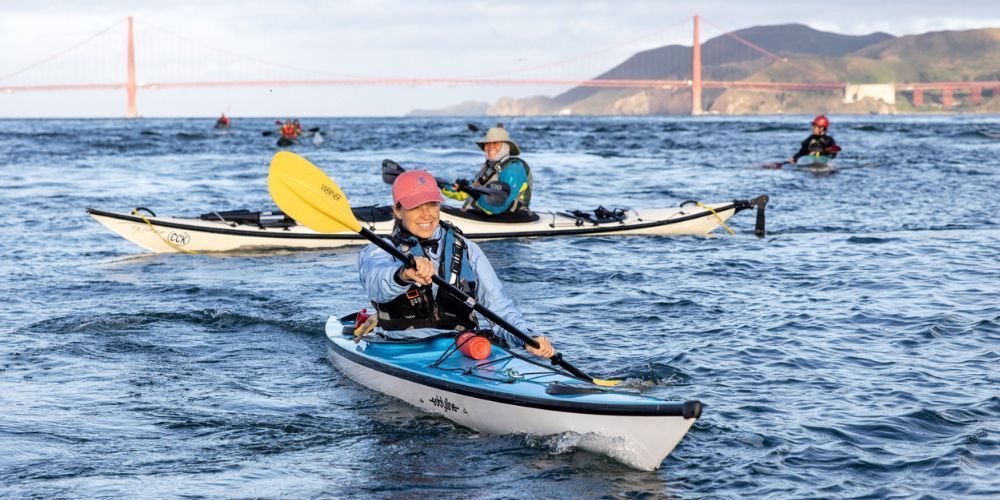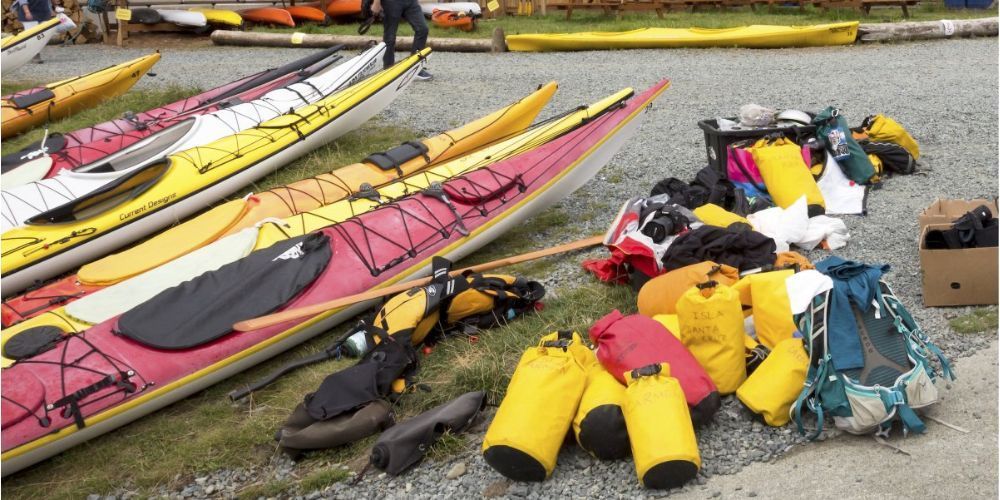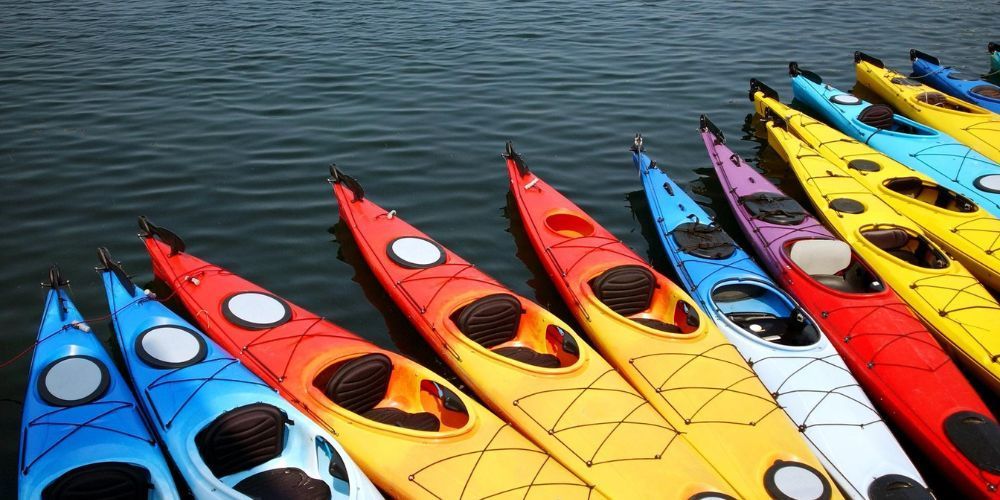The Best Kayak Paddles for Beginners in 2024
The ideal kayak paddle for a beginner is designed with ease-of-use and comfort in mind. These paddles are built to make your starting strokes feel natural, aiding your navigation through calm waters. However, there's more than just 'comfort' to look for. You might not know it, but there are two main types of kayak paddles - one tailored for smooth waterways and another that allows you to tackle choppier conditions if you choose. Let's delve deeper into the latter, shall we?
When selecting a kayak paddle, it's crucial to consider the paddle length, blade shape and width, feathered or unfeathered blades, as well as the material used for the blades and shaft. Additionally, take into account your kayaking style and preferences, such as low-angle or high-angle paddling, to ensure you choose a paddle that suits your needs.
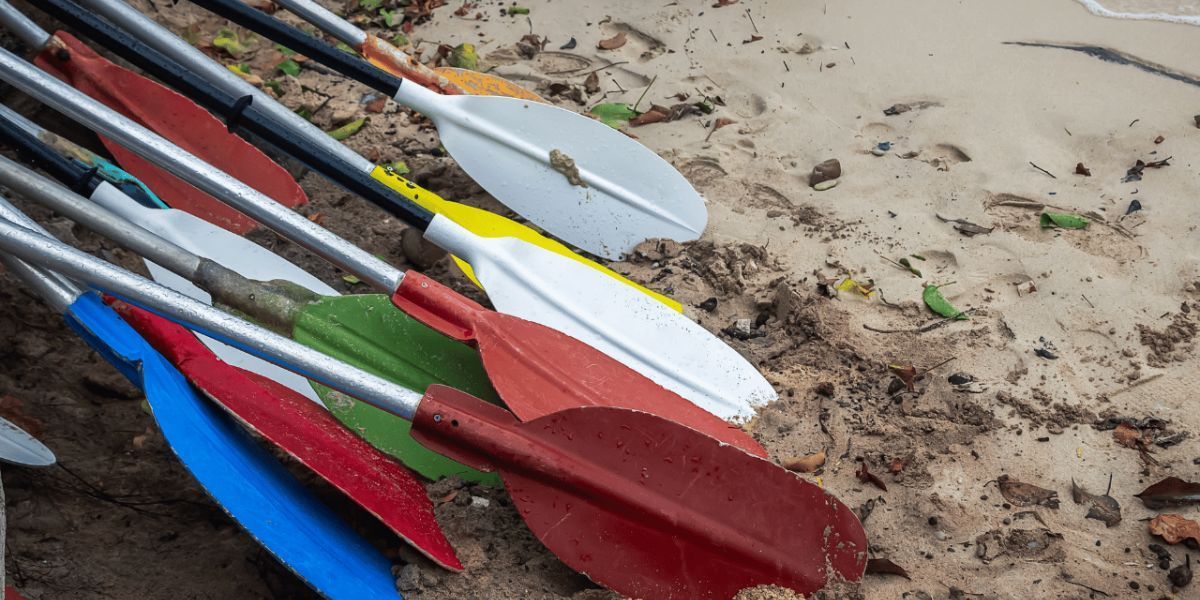
Types of Paddles
In the realm of kayak paddles, there exists a variety of types tailored to meet specific needs and preferences. Understanding the difference between high-angle and low-angle paddles is crucial, as it impacts your kayaking experience and performance on the water.
High-Angle Paddles
For those who prioritize power, agility, and rapid maneuvering, high-angle paddles are the go-to choice. If you're into more adventurous kayaking activities, such as whitewater or sea kayaking in challenging conditions, a high-angle paddle will be your ally. Engineered with a shorter, wider blade shape, these paddles enable swift acceleration and effective steering, ideal for combatting strong currents or windy conditions.
Consider navigating through fast-moving rapids where immediate responsiveness from your paddle is essential. In such scenarios, the design of a high-angle paddle ensures that each stroke delivers maximum propulsion to swiftly navigate through turbulent waters with precision and control.
Low-Angle Paddles
Conversely, low-angle paddles offer a more relaxed and leisurely kayaking experience. Suitable for savoring scenery and taking casual strolls across serene waters, low-angle paddles feature longer and narrower blades designed to provide efficient and smooth strokes with reduced strain on your arms and shoulders.
Their streamlined design enables a comfortable rhythm during extended trips, making them well-suited for recreational kayaking or leisurely exploration. With each stroke, the blade enters the water at a shallower angle, resulting in less resistance and fatigue for paddlers who prefer a more laid-back approach to their kayaking adventures.
Understanding these distinctions in paddle designs allows beginners to choose the right tool that aligns with their goals and preferences as they embark on their kayaking journey.
As we now have a solid grasp of the different types of kayak paddles suitable for various activities, it's time to delve deeper into the intricate world of blade designs and their effects.
Blade Designs and their Effects
The design of a kayak paddle blade can significantly impact your paddling performance. One important aspect to consider is whether the blades are feathered or unfeathered.
Feathered Blades are designed with an adjustable offset angle that reduces wind resistance during the recovery phase of the stroke, which can be advantageous for paddling in adverse weather conditions. However, for beginners, using feathered blades can cause strain on the wrists as they adjust to the angle while learning proper paddling techniques.
On the other hand, Unfeathered Blades are more straightforward for beginners to control, especially when starting out. However, they might catch more wind, particularly in windy conditions, requiring more effort to maintain a consistent paddling rhythm.
Understanding these design differences is crucial for beginners to make an informed decision based on their skill level and the typical conditions they will be paddling in. The goal is to find a balance between reducing wind resistance and minimizing strain on the wrists, ensuring an enjoyable and efficient paddling experience.
It's like choosing your tools for a specific job—feathered blades are like a specialized tool that needs more finesse to use effectively, while unfeathered blades are like a versatile, all-purpose tool that may require more physical effort in certain situations.
Ultimately, the best choice depends on your individual comfort and experience level. For many beginners, starting with unfeathered blades might provide a better learning experience and help build essential paddling skills without adding complexity.
By understanding how feathered and unfeathered blades impact your paddling technique and performance, you can confidently select the most suitable blade design for your kayaking adventures.
The Role of Shafts in Paddle Performance
The shaft, though it may appear to be just a simple stick, is one of the most important elements of your kayak paddle. It impacts everything from the comfort of your hands to the control you have over your kayak.
Shaft Diameter: The thickness of the shaft is a critical factor to consider. A thicker shaft provides more durability and suits those with larger hands. Conversely, a slimmer shaft offers better grip for smaller hands and reduces fatigue during extended use. It's like finding the right-sized grip on a tennis racket or a golf club—a comfortable hold makes all the difference in how well you can perform.
Consider holding a thick marker versus holding a thin pencil. They both serve the same purpose, yet one may feel more comfortable in your hand during prolonged use.
- Shaft Material: Now, let's delve into what your shaft is made of. There are three primary materials used for kayak paddle shafts: aluminum, fiberglass, and carbon fiber.
- Aluminum: Sturdy and durable but heavier, potentially causing fatigue during long trips.
- Fiberglass: Lightweight and strong, offering a good balance between sturdiness and weight.
- Carbon Fiber: Lightweight and incredibly strong, marking the epitome of efficiency and performance albeit at a higher cost.
When choosing a paddle, factor in the type of kayaking you'll be doing. For shorter trips or beginners, an aluminum or fiberglass shaft might be suitable. However, for longer trips or high-performance paddling, investing in a carbon fiber shaft should be considered.
It's like choosing between a regular bike or a professional racing bike—each has distinct qualities best suited for different types of riding.
Understanding these details about shafts will help you make an informed decision when selecting the best paddle for your needs. Every aspect contributes to your comfort and performance on the water; thus, taking the time to choose the right one will pay off in the long run.
Now equipped with insights into shafts, let's pivot to examine the crucial design and performance features that define top-notch kayak paddles.
Crucial Design and Performance Features
When it comes to choosing the right kayak paddle, several key design and performance features can significantly impact your overall experience on the water. Let's explore some of the critical factors that can make a substantial difference in how you maneuver through the waters and maintain your energy while kayaking.
Blade Material
The material used for the kayak paddle blades plays a vital role in determining its efficiency, flexibility, and durability. While plastic blades are known for their flexibility and affordability, fiberglass blades offer rigidity and lightweight properties. On the other hand, carbon fiber blades are renowned for their maximum efficiency, although they come at a higher cost. Understanding the differences between these materials can help you make an informed decision based on your specific needs and budget.
Keep in mind that the blade material can significantly impact your paddling experience. For instance, if you prioritize efficient and powerful strokes, investing in carbon fiber blades might be worth considering. However, if you're looking for a more budget-friendly option with good durability, fiberglass blades could be a suitable choice. It's crucial to weigh the advantages of each material against your kayaking goals to find the best fit for your needs.
Weight
The weight of the kayak paddle is another critical factor to consider when making your selection. A heavy paddle can lead to fatigue during long kayaking excursions, while an excessively lightweight paddle may compromise durability. Striking the right balance between durability and weight is paramount to ensuring that you have an enjoyable and sustainable kayaking experience.
To provide context, imagine the strain on your arms during an extended kayaking trip using a heavy paddle. The weight of the paddle directly affects how fatigued you may become over time, impacting your ability to fully enjoy the excursion. Therefore, finding a paddle that offers a harmonious balance between durability, performance, and weight is essential for maintaining your energy and comfort while out on the water.
By understanding these crucial design and performance features of kayak paddles , you can make an informed choice that aligns with your kayaking goals and preferences. The right combination of blade material and weight will enhance your paddling experience, making it more enjoyable and rewarding.
Now that we've covered the essential features of kayak paddles designed to elevate your experience on the water, let's delve into how to manage your expenses when seeking these essential tools—budgeting for kayak paddles.
Budgeting for Kayak Paddles
So, you're all psyched to get yourself a top-notch kayak paddle. But here's the thing - you don't want to break the bank, right? When it comes to buying your first kayak paddle, there are a few things you need to keep in mind.
Price vs. Quality: Sure, you'll find beginner paddles ranging from $30 to $150, but the real question is - do you want to buy another one soon because yours broke, or do you want to invest in a durable option that will last longer? It's a trade-off between price and durability. Of course, as a beginner, you might be hesitant to spend too much, but consider this - spending a bit more now on a higher-quality paddle could save you money in the long run.
Here's something interesting: for beginners, a good-quality paddle may take up about 20%-30% of your total gear budget. So, it's worth giving it some thought. Consider how much time you plan on spending on the water. If kayaking is really your thing and you'll be hitting the water frequently, investing in a higher-quality paddle will make your experience more enjoyable and hassle-free in the long run.
Materials like fiberglass and carbon fiber may initially seem pricey when compared to aluminum paddles. Still, they can offer substantial long-term value due to their improved performance and greater durability.
Let's say you decide to go for an aluminum paddle because it's cheaper. Aluminum is sturdy, but it's also heavier which could tire you out quickly. Now, if you opt for a fiberglass or carbon fiber paddle, they are not only lighter but also more efficient on the water. The reduced strain on your arms could well be worth the extra investment.
Maintenance Costs: It's not just about the upfront cost; it's also about long-term savings. For instance, choosing fiberglass over aluminum could save you about 15-20% in maintenance costs over five years.
So, while thinking about your budget for a kayak paddle might seem like a small thing compared to choosing the type of kayak or where to go paddling, it's actually a pretty big one! It directly affects your comfort and enjoyment on the water.
By carefully considering the cost and durability of your paddle, you'll ensure that your investment provides lasting value and enhances your kayaking experience in the long run.
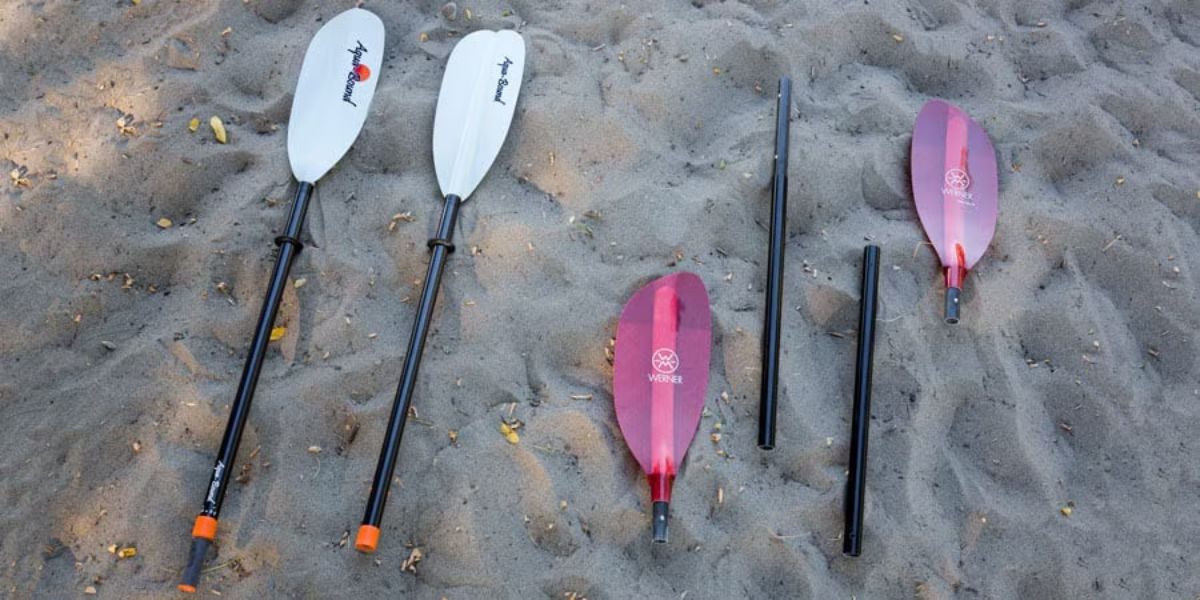
Must-Have Features in Beginner Kayak Paddles
When you're just starting out in the world of kayaking, having the right gear by your side is crucial. While beginner kayak paddles come in all shapes and sizes, there are some key features to look for to ensure a comfortable and enjoyable experience on the water.
Adjustable Length for Personalization
One of the most important features to look for in a beginner kayak paddle is its adjustable length. This feature allows for personalized sizing, ensuring that you can find the perfect paddle length suited to your height and kayaking style. Whether you're tall or short, having the ability to adjust the length of your paddle is essential for comfort and efficiency while paddling. It also comes in handy when switching between different kayaks, as you can adapt the length according to the specific kayak you're using.
Durability for Longevity
For beginners, durability is a non-negotiable feature when choosing a kayak paddle. As you're learning and mastering your paddling skills, accidental impacts and rough handling are inevitable. A durable paddle can withstand these occurrences and is less likely to get damaged. Look for materials like fiberglass or lightweight aluminum, which offer an excellent blend of strength and lightness. This not only ensures that your paddle lasts longer but also gives you the confidence to focus on honing your kayaking abilities without worrying about damaging your paddle.
From adjustable length for personalized sizing to durability for longevity, these essential features can significantly enhance your kayaking experience as a beginner, setting you up for success on the water.
Transitioning from understanding essential features of kayak paddles to making an informed decision about purchasing your first one can be both exciting and overwhelming. Now, let's navigate through practical tips that will help you make the best choice for your initial paddle investment.
Practical Tips for Buying Your First Paddle
Buying your first kayak paddle is an exciting and important step on your kayaking journey. It's akin to choosing the right wand in a magical world - it needs to feel just right! Here are some practical tips to guide you:
Testing Before Investing
Before making that commitment, it's essential to test out different paddles, just like trying on a pair of shoes before purchasing. Renting or borrowing paddles from friends or local rental shops can be a great way to assess the comfort, weight, and performance of various paddle styles. By using them in the water, you can get a tangible feel for how they handle and whether they suit your paddling style.
Seeking Expert Advice
When delving into new territory, it’s always beneficial to seek guidance from those with experience. Consulting with seasoned kayakers, visiting local kayak shops, or engaging with online communities and forums can provide invaluable personalized recommendations and insights. These resources offer insider tips on the best paddle options based on your skill level, preferences, and budget.
Expert advice not only furnishes information about paddle options but also fosters connection within the kayaking community. There’s a wealth of knowledge available that can enhance your understanding of paddling equipment and techniques.
In addition to personal experiences shared by seasoned paddlers, professional guidance from retailers or kayak instructors can help you gain a deeper grasp on what features to look for in a beginner-friendly paddle. This expert advice can pave the way for more informed decisions and set the stage for a positive introduction to your paddling pursuits.
By following these practical tips, you can enter the world of kayak paddling equipped with valuable insights that will guide you toward selecting the perfect paddle for your needs.
Embracing the process of finding your ideal kayak paddle through testing and seeking expert advice can turn buying your first paddle into an enjoyable and enlightening experience. It's all part of the fulfilling journey into the world of kayaking. Happy paddling!
Nature's Playbook
As an Amazon Associate I earn from qualifying purchases.




